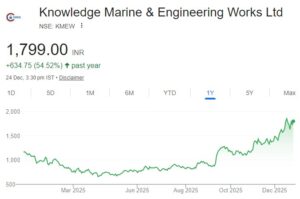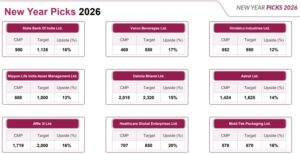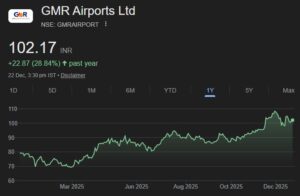

The best thing about Blue Chip stocks is that you can buy large quantities and rest easy, without having to look over your shoulder for lurking dangers. These stocks give you “reasonable return with high certainty“. They compound slowly and steadily, and turn into a multibagger with the sheer passage of time.
So, when Dipen Mehta, the accomplished stock picker, identified Bajaj Finance as his stock pick, we got all interested.
First, lets look at Bajaj Finance’s past performance.
In 12 years (01.01.2002), Bajaj Finance has given a return of 4040%. In three years (01.01.2010) it has given a return of 303% and last year (01.01.2012) it gave a return of 121%.
So, the stock has been a gorgeous multibagger. These multibagger returns have come as a result of a spectacular 3 year CAGR revenue of 54%, a 3 year CAGR profit of 128% and a ROE of about 24%. Now, is there any reason to believe that such a scorching performance will not be repeated in the next 3, 5 or 10 years?
Lets look at Bajaj Finance’s current results and see what it is about the stock that has attracted Dipen Mehta.
Bajaj Finance has put up a very spirited performance so far in the 9 months ended 31st December 2012. The AUM jumped 41.3% YOY and 9.6% QoQ to reach Rs. 16,884 crores. According to the management, the AUM will be close to Rs. 17,500 crores by March 2013. The best part is that the Gross NPAs were low at 1% and the Net NPAs were only 0.2%.
In the December 2012 Quarter, the operating income was up 36.82% to Rs. 824.68 crores while the Net Profit after tax was up 33.42% to Rs. 160.09 crores on a YOY basis.
Now, the best thing is that this stellar performance was achieved in a difficult regime with high interest rates and slow consumer discretionary spending. Hopefully, when the interest rates dip and the economy recovers, Bajaj Finance will be able to perform better.
| Bajaj Finance’s Financials | |||
|---|---|---|---|
| (Rs cr) | Dec 2012 | Dec 2011 | YOY |
| Operating Income | 824.68 | 602.76 | 36.82 |
| Total Expenses | 215.87 | 181.88 | 18.69 |
| Operating Profit | 608.81 | 420.88 | 44.65 |
| Other Income | 3.55 | 0.80 | 343.75 |
| PBDIT | 612.36 | 421.68 | 45.22 |
| PBT | 236.60 | 177.47 | 33.32 |
| Adjusted Net Profit | 160.09 | 119.99 | 33.42 |
Now, lets’ look at the valuations. The diluted EPS for the 9 months ended 31st December 2012 was Rs. 102.34 and the Book Value per share was Rs. 575. If you extrapolate the EPS for 12 months, it will be Rs. 136. A rights issue for issue of 67,60,117 equity shares of Rs 10 each at a price of Rs 1100 per share (inclusive of premium of Rs 1090 per share), aggregating to Rs 743.61 crore has been announced. This will result in a dilution of nearly 16% (ignoring oversubscription). The share premium will swell by Rs. 736 crores, leading to a estimated Book Value of Rs. 667 per share {Net Worth as of 31.03.2012 (Rs. 2,034 crore) + estimated NP for FY 2013 (Rs. 569 crore) + share premium addition (Rs. 735 crore) = Rs. 3,339 crore / nos of shares (nearly 5 crore)}
Now, assuming this hypothesis is correct, Bajaj Auto is quoting at a Price to Book of 1.93 times at the CMP of Rs. 1,290 and a PE of 11.31 (assuming diluted EPS for the whole year of Rs. 114). This is not challenging at all when you consider Bajaj Finance’s pedigree and track record. Also, if you benchmark with other NBFCs like Shriram Transport and Mahindra & Mahindra Finance, you will find the valuations very reasonable. If you extrapolate further to FY 2014, the position becomes even more comfortable.
Another viable option is Bajaj Finserv which owns 74% of Bajaj Allianz Life Insurance Co, 74% of Bajaj Allianz General Insurance Co and 61.91% of Bajaj Finance apart from certain Wind Mills and finance operations.
Bajaj Finserv has also had a scorching performance in the 9 months ended 31st December 2012. The Q3FY13 revenue soared 35% to Rs. 1,119 crore while the Net Profit soared 46% to Rs. 248 crore. The diluted EPS (after rights issue) for the 9 months was Rs. 43.8. Extrapolating on the same basis as in FY 2012 (there is a transfer from policy holders’ a/c that takes place in Q4), the EPS for the full year should be around Rs. 128 resulting in a PE of around 6.6 at the CMP of Rs. 850. The Book Value per share for the year ended 31st March 2013 should be close to Rs. 500, resulting in a competitive PBV of about 1.7 which is cheaper than that of its peers.
| Bajaj Finserv Financials | |||
|---|---|---|---|
| (Rs cr) | Dec 2012 | Dec 2011 | YOY |
| Operating Income | 1,119.83 | 825.19 | 35.71 |
| Total Expenses | 244.64 | 209.27 | 16.90 |
| Operating Profit | 875.19 | 615.92 | 42.09 |
| Other Income | 0.88 | 0.38 | 131.58 |
| PBDIT | 876.07 | 616.30 | 42.15 |
| PBT | 499.80 | 371.60 | 34.50 |
| Adjusted Net Profit | 248.71 | 170.06 | 46.25 |
So, the bottom line is that one can’t go wrong with either of the two Bajaj financial powerhouses.





